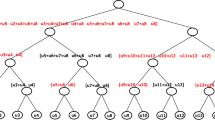Abstract
In this paper we explore algorithms and architectures for the implementation of a MIMO OFDM Equalizer for high speed wireless communications. The algorithmic exploration is based on matrix computations and factorizations. A scalable computational methodology and architecture is proposed for the implementation of a 4×4 MIMO OFDM. A 2×3 Equalizer supporting Maximum Ratio Combining and Zero Forcing equalization for 20/40 MHz 64-QAM OFDM modulation has been implemented in 150 nm technology. The Equalizer area is 133k gates and the maximum throughput achieved is 480Mbits/s. The system described in this paper is compliant with the latest IEEE standard for MIMO wireless communications (802.11n)












Similar content being viewed by others
References
Golub, V. L. (1996). Matrix computations. Baltimore: John Hopkins.
Walther, J. S. (1971). A unified algorithm for elementary functions. In Spring joint computer conf (pp. 379–385).
Paulaj, et al. (2003). Introduction to space-time wireless communications. Cambridge: Cambridge University Press.
Hassibi, B., & Vikalo, H. (2003). Maximum-likelihood decoding and integer least-squares: The expected complexity. Providence: American Mathematical Society.
Heiskala, J., et al. (2001). OFDM wireless LANs: A theoretical and practical guide.
Paulraj, A. J., et al. (2004). An overview of MIMO communications—a key to gigabit wireless. Proceedings of the IEEE 92(2), 198–218.
Zheng, L., & Tse, D. (2003). Diversity and multiplexing: A fundamental tradeoff in multiple-antenna channels. IEEE Transactions on Information Theory, 49(5), 1073–1096.
Tarokh, V., et al. (1998). Space-time codes for high data rate wireless communication: Performance criterion and code construction. IEEE Transactions on Information Theory, 44(2), 744–765.
Wolniasky, P. W., et al. (1998). V-BLAST: An architecture for realizing very high data rates over the rich-scattering wireless channel. In Proc. URSI ISSSE (pp. 295–300).
Artes, H., et al. (2003). Efficient detection algorithms for MIMO channels: A geometrical approach to approximate ML detection. IEEE Transactions on Signal Processing, 51(11).
Tse, D., & Viswanath, P. (2005). Fundamentals of wireless communications.
Press, W., et al. (1988). Numerical recipes in C. Cambridge: Cambridge University Press.
Trefethen, L., & Bau, D. (1997). Numerical linear algebra. Philadelphia: SIAM.
Rader, C. M. (1996). VLSI systolic arrays for adaptive nulling. IEEE Signal Processing Magazine.
Burg, A., Felber, N., & Fichter, W. (2003). A 50 Mbps 4×4 maximum likelihood decoder for multiple-input multiple-output systems with QPSK modulation. In Proc. IEEE Int. Conf. Electr., Circuits, Syst. (Vol. 1, pp. 332–335).
Wong, K., Tsui, C., Cheng, R., & Mow, W. (2002). A VLSI architecture of a K-best lattice decoding algorithm for MIMO channels. In Proc. IEEE ISCAS’02 (Vol. 3, pp. 273–276).
Guo, Z., & Nilsson, P. (2003). A VLSI implementation of MIMO detection for future wireless communications. In Proc. IEEE PIMRC’03 (Vol. 3, pp. 2852–2856).
Garrett, D., Woodward, G., Davis, L., Knagge, G., & Nicol, C. (2004). A 28.8 Mb/s 4×4 MIMO 3G high-speed downlink packet access receiver with normalized least mean square equalization. In Proc. IEEE ISSCC’04 (Vol. 1, p. 420).
Hu, Y. H. (1992). CORDIC based VLSI-architectures for digital signal processing. IEEE Signal Processing Magazine, 16–35.
Proakis, J. (2000). Digital communications. New York: McGraw-Hill.
Gore, D., Sandhu, S., & Paulraj, A. (2002). Delay diversity codes for frequency selective channels. In Proceedings of IEEE international conference on communications.
Bingham, J. (1990). Multicarrier modulation for data transmission: An idea whose time has come. IEEE Communications Magazine, 28(5), 5–14.
Burg, A., et al. (2006). Algorithm and VLSI architecture for linear MMSE detection in MIMO-OFDM systems. In IEEE symbosium on circuits and systems, 2006. ISCAS 2006 (pp. 4–8).
Luethi, P., et al. (2008). Gram-Schmidt-based QR decomposition for MIMO detection: VLSI implementation and comparison. In IEEE Asia Pacific conference on circuits and systems, 2008. APCCAS 2008 (pp. 830–833).
Luethi, P., et al. (2007). VLSI implementation of a high-speed iterative sorted MMSE QR decomposition. In Proc. of IEEE ISCAS (pp. 1421–1424).
Author information
Authors and Affiliations
Corresponding author
Rights and permissions
About this article
Cite this article
Sarrigeorgidis, K., Ma, Y. Algorithmic Exploration and Implementation of a MIMO-OFDM Equalizer. J Sign Process Syst 61, 141–156 (2010). https://doi.org/10.1007/s11265-009-0411-y
Received:
Revised:
Accepted:
Published:
Issue Date:
DOI: https://doi.org/10.1007/s11265-009-0411-y




